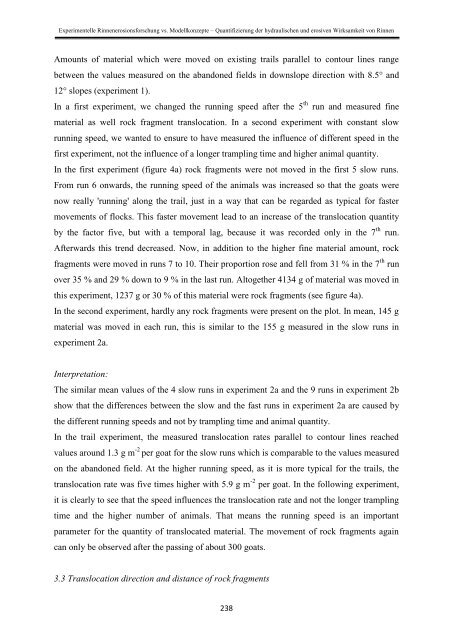Stefan Wirtz Vom Fachbereich VI (Geographie/Geowissenschaften ...
Stefan Wirtz Vom Fachbereich VI (Geographie/Geowissenschaften ...
Stefan Wirtz Vom Fachbereich VI (Geographie/Geowissenschaften ...
Create successful ePaper yourself
Turn your PDF publications into a flip-book with our unique Google optimized e-Paper software.
Experimentelle Rinnenerosionsforschung vs. Modellkonzepte – Quantifizierung der hydraulischen und erosiven Wirksamkeit von Rinnen<br />
Amounts of material which were moved on existing trails parallel to contour lines range<br />
between the values measured on the abandoned fields in downslope direction with 8.5° and<br />
12° slopes (experiment 1).<br />
In a first experiment, we changed the running speed after the 5 th run and measured fine<br />
material as well rock fragment translocation. In a second experiment with constant slow<br />
running speed, we wanted to ensure to have measured the influence of different speed in the<br />
first experiment, not the influence of a longer trampling time and higher animal quantity.<br />
In the first experiment (figure 4a) rock fragments were not moved in the first 5 slow runs.<br />
From run 6 onwards, the running speed of the animals was increased so that the goats were<br />
now really 'running' along the trail, just in a way that can be regarded as typical for faster<br />
movements of flocks. This faster movement lead to an increase of the translocation quantity<br />
by the factor five, but with a temporal lag, because it was recorded only in the 7 th run.<br />
Afterwards this trend decreased. Now, in addition to the higher fine material amount, rock<br />
fragments were moved in runs 7 to 10. Their proportion rose and fell from 31 % in the 7 th run<br />
over 35 % and 29 % down to 9 % in the last run. Altogether 4134 g of material was moved in<br />
this experiment, 1237 g or 30 % of this material were rock fragments (see figure 4a).<br />
In the second experiment, hardly any rock fragments were present on the plot. In mean, 145 g<br />
material was moved in each run, this is similar to the 155 g measured in the slow runs in<br />
experiment 2a.<br />
Interpretation:<br />
The similar mean values of the 4 slow runs in experiment 2a and the 9 runs in experiment 2b<br />
show that the differences between the slow and the fast runs in experiment 2a are caused by<br />
the different running speeds and not by trampling time and animal quantity.<br />
In the trail experiment, the measured translocation rates parallel to contour lines reached<br />
values around 1.3 g m -2 per goat for the slow runs which is comparable to the values measured<br />
on the abandoned field. At the higher running speed, as it is more typical for the trails, the<br />
translocation rate was five times higher with 5.9 g m -2 per goat. In the following experiment,<br />
it is clearly to see that the speed influences the translocation rate and not the longer trampling<br />
time and the higher number of animals. That means the running speed is an important<br />
parameter for the quantity of translocated material. The movement of rock fragments again<br />
can only be observed after the passing of about 300 goats.<br />
3.3 Translocation direction and distance of rock fragments<br />
238
















